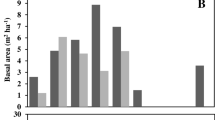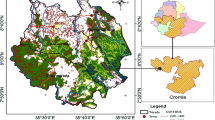Abstract
Quantifying the amount of carbon pools in church forest ecosystems enables us to understand about the role of church forest for climate change mitigation and adaptation. Therefore, this study was conducted with the goal of estimate the amount of carbon stored for some commonly grown planted trees in the Abune Teklehyimanot Church, Welayita Sodo, Southern Nations, Nationalities and Peoples Regional State, Welayita town, Ethiopia. In 2018, a total of 23 temporarily sample plots with an area of 110 to 578 m2 each were established, laid out on transects along altitudinal gradients with a distance of 100 m between plots. All trees with diameter at breast height (DBH) ≥ 2 cm were identified and height (m) was measured using diamater tape, calliper and vertex (digital height measurement instrument). Aboveground and belowground biomass was calculated using Chave et al. (Global Change Biology 3177–3190, 2014) and IPCC (National Greenhouse Gas Inventories Program, IGES, Japan, 2006), respectively, and converted into carbon density using the default factor. Data analysis made using descriptive statistics. The aboveground biomass of the natural forest ranged from 241.41 ± 5.50 t ha−1 for Eucalyptus camaldulensis to 1.60 ± 0.00 for Jacaranda mimosifolia at Teknik na Muya mender forest 24 patch. The belowground biomass ranged from 27.23 ± 0.62 t ha−1 for Eucalyptus camaldulensis at Teknik na Muya mender forest patch to 0.01 ± 0.00 t ha−1 for Juniperus procera. The mean ecosystem carbon stock density of the sampled plots in the planted forest ranged from 140.70 ± 3.21 t C to 0.06 ± 0.005 ha−1 for Eucalyptus camaldulensis and Juniperus procera, respectively. In conclusion, fast growing introduced tree species accumulated more carbon stock than native tree species in the studied period of time. There was variation in carbon pools among a species and forest patches. We recommend forest carbon-related awareness creation for local people and promotion of the local knowledge as a possible option for sustainable forest management. This forest needs management intervention including enrichment planting of economically important native tree species and fencing to avoid free grazing by livestock. Better attention of development practitioners, policy makers and church communities may help to improve the woody species composition of this forest and conservation role of Ethiopian Orthodox church.
Access this chapter
Tax calculation will be finalised at checkout
Purchases are for personal use only
Similar content being viewed by others
References
Adugna F, Teshome S, Mekuria A (2013) Forest Carbon Stocks and Variations along Altitudinal Gradients in Egdu Forest: Implications of Managing Forests for Climate Change Mitigation. Sci Technol Art Res J 2(4):40–46
Atta-Boateng J, Moser JR (1998) A method for classifying commercial tree species of an un even-aged mixed species tropical forest growth and yield model construction. For Ecol Manage 104:89–99. http://www.fao.org/forestry/25518/en/
Beets PN, Oliver GR, Clinton PW (2002) Soil carbon protection in Podocarp/hardwood forest and effects of conversion to pasture and exotic pine forest. Environ Pollut 116:S63–73. PMID: 11833919 (PubMed- Indexed for MEDLINE)
Brown S (1997) Estimating biomass and biomass changes of tropical forests: a primer : FAO Forestry Paper 134, FAO. United Nations, Rome
Chave J, Rieâra B, Dubois M (2001) Estimation of biomass in a neotropical forest of French Guiana: spatial and temporal variability. J Trop Ecol 17:79–96
Chave J, Réjou-Méchain M, Búrquez A, Chidumayo E, Colgan MS, Delitti WBC, Vieilleden G (2014) Improved allometric models to estimate the aboveground biomass of tropical trees. Global Change Biol 3177–3190. https://doi.org/10.1111/gcb.12629
Desalegn G, Abega M, Teketay D, Gezahgne A (2012) Commercial timer species in Ethiopia: characteristics and uses—a handbook for forest industries, construction and energy sectors, foresters and other stakeholders. Addis Ababa University Press, Addis Ababa
Friss I, Demissew S, van Bruegel L (2010) Atlas of potential vegetation of Ethiopia. Biologiske skrifter (Biol Skr Dan Vid Selsk) 58:307
Gebre TM (2015) Biomass and soil carbon stocks along elevation gradeints of woodland ecosystems. The case of Liben district, South Ethiopia. MSc Thesis, WGCF, Shashemene, Ethiopia
Gibbs HK, Brown S, Niles JO, Foley JA (2007) Monitoring and estimating tropical forest carbon stocks: making REDD a reality. Environ Res Lett 2:045023
Girma A, Soromessa T, Bekele T (2004) Forest carbon stocks in woody plants of mount zequalla monastery and its variation along altitudinal gradient: implication of managing forests for climate change mitigation. Sci Technol Arts Res J 3(2):133–141
Girma A, Soromessa T, Bekele T (2014) Forest carbon stocks in woody plants of Mount Zequalla Monastery and its variation along altitudinal gradient: Implication of managing forests for climate change mitigation. Sci Technol Arts Res J 3(2):132–140
Harms BP, Dalal RC, Cramp AP (2005) Changes in soil carbon and soil nitrogen after tree clearing in the semi—arid range lands of Queensland. Aust J Bot 53:639–650. https://doi.org/10.1071/BT04154
Hassen N (2015) Carbon stock along altitudinal gradient in Gera Moist Evergreen Afromontane forest, South Western Ethiopia, MSc Thesis, AAU, Addis Ababa, Ethiopia
Houghton RA (1998) The annual net flux of carbon to the atmosphere from changes in land use 1850–1990 Tellus B 51:298–313
IBC (2005) National biodiversity strategy and action plan. Institute of Bodiversity Conservation, Addis Ababa, Ethiopia
IPCC (2006) Guidelines for national greenhouse gas inventories (Vol 4, AFOLU). In: Egsleston HS, Buendia L, Miwa K, NgaranT, Tanabe K (eds) National greenhouse gas inventories program. IGES, Japan
Iticha B (2017) Ecosystem carbon storage and partitioning in Chato Afromontane forest. Its climate change mitigation and economic potential. Int J oEnviron Agric Biotechnol (IJEA B) 2(4):2450–1878
Kangas A, Maltamo M (2006) Forest inventory methodology and applications: managing forest ecosystems 10. Springer, Dordrecht, the Netherlands
Kassahun K, Soromessa T, Belliethathan S (2015) Forest carbon stock in woody plants of Ades Forest, Western Haraghae Zone of Ethiopia and its variation along environmental factors: Implications for climate change mitigation. J Nat Sci Res 5(21). www.iiste.org
Köhl M, Magnussen SS, Marchett M (2006) Sampling methods, remote sensing and GIS multi resource forest inventory. Springer, Berlin
Meles BW, Kelbessa E, Soromessa T (2014) Forest carbon stocks in woody plants of arba minch ground water forest and its variations along environmental gradients. Sci Technol Arts Res J 3(2):141–147
Moges Y, Eshetu Z, Nune S (2010) Ethiopian forest resources: Status and future Management options in view of access to carbon finances. Ethiopian Climate Research and Networking Report, UNDP, Addis Ababa, Ethiopia
Pearson T, Walker S, Brown S (2005) Source book for land use, land—use change and forestry projects
Pearson T, Brown S,Birdsey R (2007) Measurement guidelines for the sequestration of forest carbon. Northern Research Station, Department of Agriculture, Washington, DC
Ponce-Hernandez R (2004) Assessing carbon stocks and modeling win–win scenarios of carbon sequestration through land-use changes. FAO, UN, Rome
Shumi G (2009) The structure and regeneration status of tree and shrub species of Chilimo forest—Ecological suatainability indicators for participatory forest management (PFM) in Oromia, Ethiopia. MSc Thesis, University of Dresden, Germany
Sisay N (2010) Land use, land use change and forestry (LULUCF): Afforestation and Reforestation. In: Clean development mechanisms investor’s Guide, DNA office the Environment Protection Authority, EPA, Addis Ababa, Ethiopia
Temam A (2010) Impact of disturbance on carbon stocks in HaranaBulluk natural forests, Bale Zone, SW Ethiopia. MSc Thesis, Wondogenet College of Forestry, Shashemene, Ethiopia
Tesfaye AM (2015) Forest management options for carbon stock and soil rehabilitation in Chilimo dry afromontane forest, Ethiopia. Ph.D. Thesis, INIA- Palencia, University of Valladolid, Palencia, Spain
Tesfaye MA, Bravo F, Ruiz-Peinado R, Pando V, Bravo-Oviedo A (2016) Impact of Changes in land use, species and elevation on soil organic carbon and total nitrogen in Ethiopian Central Highlands. Geoderma 261: 70–79. 0016–7061/© 2015 Elsevier B.V. All rights reserved
Tesfaye AM, Gardi O, Tesfaye B, Jűrgen B (2019) Temporal variation of ecosystem carbon pools along altitudinal gradient and slope: the case of Chilimo dry afromontane natural forest,Central Highlands of Ethiopia. Int J Ecol Environ. https://doi.org/10.1186/s41610-019-0112-9
Teshome and Nesibu (2019) Progress report of welayita sodo Monastery forest, Addis Ababa, Ethiopia
Tsegaye T (2010) Bale Eco-region sustainable management programme. http://www.pfmpfarmsos.org/publication.html
Twongyirwe R, Sheil D, Majaliwa JGM, Ebanyat P, Tenywa MM, Van Heist M, Kumar L (2013) Variability of soil organic carbon stocks under different land uses: A study in an afromontane landscape in South-Western Uganda. Geoderma 193–194, 282–289. https://doi.org/10.1016/j.Geoderma.2012.09.005
Wassie A (2002) Opportunities, constraints and prospects of ethiopian orthodox tewahedo church I conserving forest resources. The case of churches in South Gonder, Northern Ethiopia, MSc Thesis, Swedish University of Agricultural Sciences. Skinnskatterberg, Sweden
Wassie A, Teketay D, Powell N (2005) Church forests in North—gonder administrative zone, Northern Ethiopia. Forest Trees Livelihood 15:349–373
Wassie A, Streck FJ, Teketay D andBongers T (2009) Effects of livestock exclusion on tree regeneration on church forests of Ethiopia. For Ecol Manag 257(3):765–772
Wodajo A (2018) Variation in carbon stock along environmental gradients in Gara—Muktar Forest, West Herargae Zone, Southern Ethiopia, MSC Thesis, Haromaya University, Dire Dawa, Ethiopia
Yahya (2015) Carbon stock along altitudinal gradient of Araba Gugu Dry afromontane forest, MSC Thesis, HAFl, Switzerlands
Yelemfrhat T, Soromessa T, Bayable E (2014) Forest carbon stocks in lowland area of Semien Mountains National Park: Implication forclimate change mitigation. Sci Technol Arts Res J 3(3):29–36
Zanne A, Lopez-Gonzalez G, Coomes D, Ilic J, Jansen S, Lewis L, Miller B, Swenson G, Wiemann C, Chave J (2009) Global wood density database [http://hdl.handle.net/10255/dryad.235]
Author information
Authors and Affiliations
Editor information
Editors and Affiliations
Rights and permissions
Copyright information
© 2022 The Author(s), under exclusive license to Springer Nature Switzerland AG
About this paper
Cite this paper
Alebachew, M., Eshete, A., Teshome, M. (2022). Aboveground and Belowground Carbon Pools for Some Selected Native and Introduced Tree Species of Abune Teklehayimanot Church Forest, Welayita Sodo, Southern Ethiopia. In: Kindu, M., Schneider, T., Wassie, A., Lemenih, M., Teketay, D., Knoke, T. (eds) State of the Art in Ethiopian Church Forests and Restoration Options. Springer, Cham. https://doi.org/10.1007/978-3-030-86626-6_7
Download citation
DOI: https://doi.org/10.1007/978-3-030-86626-6_7
Published:
Publisher Name: Springer, Cham
Print ISBN: 978-3-030-86625-9
Online ISBN: 978-3-030-86626-6
eBook Packages: Earth and Environmental ScienceEarth and Environmental Science (R0)




